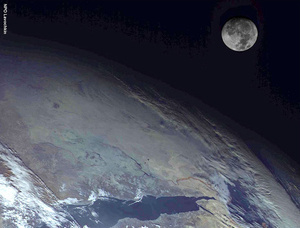Lilian Nattel's Blog, page 47
April 3, 2011
Squabbling, a Fable
This morning, while skating, I realized that there is an untold story, the sequel to Solomon's judgment over the 2 women whose motherhood was in dispute.
His next case involved a mom and 2 kids. Both kids claimed that the woman was her mom and ought, therefore, to do as the child asked, no–required–which meant essentially the opposite of what the other child wished. The woman and the children came before Solomon to judge, and he could barely hear himself think while the children spoke over each other, bickering even before the great and wise king. He wisely said, Well, I shall soon know whose mother this is. I shall cut her in half and give you each a piece. Is that all right with you? And you?
And then he didn't know what to do as the children agreed, as children will, that it was just fine with them.
Filed under: Fun Tagged: Solomon's other case








April 2, 2011
my favourite poem for #NationalPoetryMonth
"Now I Become Myself" by May Sarton http://ow.ly/4rXJ8
Filed under: Literary Tagged: May Sarton, National Poetry Month








so this is why ella fitzgerald is famous!
Wow what a voice.
[image error]
I like the above version best (more bluesy) but there is a higher audio quality version of her singing on tv here.
Filed under: Beautiful Tagged: Ella Fitzgerald Summertime








Kevas südames / Spring in the heart – Lifestyle & Culture Photos – Vaido's Photoblog

via vaido.aminus3.com
I've already posted a photo this morning–but I had to post this one too.
Filed under: Miscellany








cowboy photo, should be a classic
April 1, 2011
greens force historic change of power
how not to handle bad reviews | Books | guardian.co.uk
Writers, said the science fiction author Isaac Asimov, fall into two groups: "Those who bleed copiously and visibly at any bad review, and those who bleed copiously and secretly at any bad review.
via guardian.co.uk
And now the internet shows all the bleeding publicly–reviewers and reviewed in battle. Full story at link above.
Filed under: Miscellany








now i've seen everything in American politics…
On Wednesday, Montana Republican Congressman Alan Hale used the GOP anti-government "job killer" line to defend drunk driving. He argued that drunk driving laws were killing "small businesses" in his state– small businesses like taverns that make money and "create jobs" by sometimes sending people off into the night bubbly in the head and weaving down Montana roadways.
via coloradoindependent.com

Filed under: Miscellany Tagged: americans for drunk driving








March 31, 2011
What are the books to pass on to the next generation?
The Guardian asks readers + writers to name 1 classic. Yr choice? http://ow.ly/4qj7I
Filed under: Miscellany








point of view, Russian spacecraft takes pics of earth that look way diff than NASA's
Why Do These Breathtaking Russian Images of Earth Look So Different from NASA's?
While this morning's orbital image of Mercury is historic, these two images are the ones that have truly left me in complete awe today. Even more so than the most accurate, highest resolution view of Earth to date.
But unlike Blue Marble, these images are not by NASA. In fact, they look a lot different from NASA's Earth imagery. Much better and crispier, some may say. But are they really better? Are they more accurate? NASA has explained to us why they look so different compared to their own.
The russians are back in the space raceIt was taken by a Russian spacecraft, a new weather satellite called Elektro-L. It's now orbiting Earth on a geostationary orbit 36,000 kilometers above the equator, after being launched on January 20 from the Baikonur Cosmodrome, on board a Zenit rocket.
This is the first major spacecraft fully developed in post-Soviet Russia, developed by NPO Lavochkin for the Russian Federal Space Agency. This is a major step in the country's aerospace industry, after two decades of trouble developing anything new and living from the past glories of the Soviet system (which are great on their own right).
Elektro-L is a 1620-kilogram beast, consuming 700W from its 1.7kW solar panels. Its design is modular, with a service part called Navigator and a payload part that contains the spacecraft weather monitoring equipment. A future satellite, the space telescope Spektr-R, will use the same base module with a different payload.
In the case of Elektro-L, the payload is a 1-kilometer-per-pixel resolution camera for the visible spectrum and a 4-kilometer-per-pixel one for infrared. The spacecraft sends images every 30 minutes using a 2.56 to 16.36 Mbits per second connection with ground control. In case of emergency, the agency says, they can throttle up the frequency to 10 minutes per image.
Click on the images to expand
Why do they look different from NASA's?But all this technological terror is nothing compared to the beauty of these images. The top image shows the Moon over the Red Sea region. The one next to these lines is an incredibly detailed view of our planet, showing Africa, Arabia and India.
I don't know what Instagram filters the Russians are using, but there's something about these low-saturation photographs that mesmerizes me. They seem more real than NASA's, but in fact, the are not. According to Robert Simmon—a scientist at the NASA Earth Observatory, Goddard Space Flight Center—the Russian images are not better or worse than their images. They are just different visualizations of reality based on different data sets:
Elektro-L is a Russian Satellite similar to GOES (the satellites that provide the cloud image loops shown on the news every night). The images posted by Gizmodo are a combination of visible and near-infrared wavelengths, so they show the Earth in a way not visible to human eyes (vegetation looks red, for example). They're not any better or worse than NASA images, but they show different things.
The Elektro-L is similar to their GOES satellites. "It's a geostationary weather satellite orbiting above the equator at ~54˚ East" says Robert, "the US has two similar operational geostationary satellites over the east and west coasts, EUMETSAT has one over Europe and one over the Indian Ocean, Japan has one over the far western Pacific." The difference between them is that Elektro-L uses three bands in reflected light—red and two near infrared bands—while NASA's GOES doesn't have the near-infrared.
Dennis Chesters, GOES Project Scientist at Goddard, explains the Russian process:
The 3 reflected sunlight bands can simulate a conventional red-green-blue color picture. The near infrared channel is a vegetation indicator, since plants reflect near-ir as well as green. You can learn more about the basic characteristics of Elektro-L's ten-channel imager, the Multichannel Scanning Unit (MSU), here.
NASA's GOES imagery, however, comes in black and white. It captures images in multiple infrared wavelengths, which is unlike any photo you can imagine. The final color images that GOES produces "are a combination of visible light, thermal infrared, and the Blue Marble."
Which images are more accurate?Blue Marble uses true color images, combining red, green and blue into a global composite and rendered in a 3D program. It's actually what the eye can see. The Russian satellite, however, is presenting a different view. It may feel more realistic, but it's not.
I wouldn't really say one approach is more accurate than another: Viewing the Earth in different wavelengths gives scientists different information. Since the Blue Marble is true color, images based on it are easier for non-experts to interpret than false-color images. However, it's composed of many days of data, so won't be as detailed as single images at the same resolution, and shows a fixed point in time. It does show the whole globe, while Elektro-L will only show the hemisphere it's facing.
All these are similar processes to the ones used by astronomers to create the Hubble's images in Photoshop. To me, all the results—no matter what part of the spectrum they cover—are equally as beautiful and inspiring. [Russian Space Web via Facebook]
Send an email to Jesus Diaz, the author of this post, at jesus@gizmodo.com.
Follow Gizmodo on Facebook
[image error]'); [image error]
Your version of Internet Explorer is not supported. Please upgrade to the most recent version in order to view comments.
[image error]
m57 03/30/11
[image error]
Invite a friend to comment
It's all about the photo processing, but if you look at the shots from the moon, it's only a little color enhancement. For Saturn and Jupiter, sure NASA does a lot of color enhancement, those planets are pretty dull in real life, but earth looks great no matter how you see it. Deep blues, browns, and white clouds. Reply
Dan Nunes 03/30/11
[image error]
Invite a friend to comment
> 2.56 to 16.36 Mbits
How is it that a satellite can get faster broadband than I do at home? Reply
gnarwhal promoted this comment
AJ 03/30/11
[image error]
Invite a friend to comment
With America deciding it's better to fund war then I don't see us returning anytime soon – the Russians and the ESA have better shots and will probably take them. Reply
tomsomething 03/30/11
[image error]
Invite a friend to comment
Gah! You changed the title of the article, so I thought it was a different article from the one I read earlier today, so I clicked it, and then the click stats for the website went up! Gah! Gah! Reply
Nitesh 03/30/11
[image error]
Invite a friend to comment
Why are they different? Its probably a Nikon vs Canon thing Reply
winstonsicle 03/30/11
[image error]
Invite a friend to comment
If you look closely at the Blue Marble Image, you can actually see what appear to be the sharp edges of a low-poly 3d-model. You'd think that NASA would at least subdivide the faces a little more for the final render. Or maybe they just got a little lazy with their polygon select tool when they composited in the atmospheric glow. It's kind of disappointing to know how artificial that photo actually is.Reply
Edited by winstonsicle at 03/30/11 3:18 PM
GitEmSteveDave♥ Elizabeth Lambert 03/30/11
[image error]
Invite a friend to comment
Because they use pencils? No, that can't be it. Uhhhhh, they use Kodachrome film? Reply
Erik the Red 03/30/11
[image error]
Invite a friend to comment
So the question of the day is:If something is in a geostationary position, is it technically "orbiting"?
Ponder. Reply
See 14 replies Hide 14 replies
Curves 03/30/11
[image error]
Invite a friend to comment
Hello Honored Mother. Sometimes we forget how wonderful and truly beautiful you really are, and it takes a new perspective to remind us. Reply
2nd White Line 03/30/11
[image error]
Invite a friend to comment
Top image has been rotated 90 degrees to the right, so it's sideways. Reply
RainyDayInterns 03/30/11
[image error]
Invite a friend to comment
Have to say that astronomy, or more specifically astrophotography, is the last refuge for the true geeksIt is one of the few places untouched by "big business", where tech advances are still coming from folks working out of REAL garages, and where the sharing of information is free and without reservation.
Of course, the gear has gone a bit further than just big telescope…witness the HyperStar:[www.rainydaymagazine.com]
Here it is coupled with an appropriate ccd camera:[www.rainydaymagazine.com]
This setup will let you capture some pretty awesome images:[www.hyperstarimaging.com]
…even if you are in a light-polluted city…all without staying out all night!!! Reply
Jones Foyer 03/30/11
[image error]
Invite a friend to comment
"Click on the images to expand" The second image of earth does not. Maybe it's just my browser. #corrections Reply
Jesus Diaz promoted this comment
Edited by Jones Foyer at 03/30/11 11:41 AM
impendingdoom3 03/30/11
[image error]
Invite a friend to comment
"This is the first major spacecraft filly developed in post-Soviet Russia"
I'm sure you meant fully
#corrections Reply
Jesus Diaz promoted this comment
BeerManMike 03/30/11
[image error]
Invite a friend to comment
That's no moon! That's a… wait yea, it's a moon. Reply
butaneko promoted this comment
Ryan 03/30/11
[image error]
Invite a friend to comment
Wait waitwaitwaitwait. Combine this with the previous article. Russian tech can get a 16 Megabit connection to a satellite twenty-two thousand miles away, and I can't get ONE BAR on my AT&T phone in an office less than a mile from a cell tower?Boys, we just lost the Cold War. Reply
robot-shmobot 03/30/11
[image error]
Invite a friend to comment
"I don't know what Instagram filters the Russians are using, but there's something about these low-saturation photographs that mesmerizes me."I'm not too sure of the method here, but it seems to be true colour. The NASA Blue Marble image was probably over-saturated in post. There's just no way the earth is that green and blue from above. Reply
bigcamcrsx 03/30/11
[image error]
Invite a friend to comment
Does Giz have a spell check program?This is the first major spacecraft filly developed in post-Soviet Russia
I believe you wanted "fully"
At least run the article through Word first. Reply
Ben R promoted this comment
Edited by bigcamcrsx at 03/30/11 11:10 AM
bwb3 03/30/11
[image error]
Invite a friend to comment
The Click to Expand doesn't work and the images block text.(On a Safari browser) I really dislike this new and "improved" page design. TERRIBLE! Reply
AlfLup approved this comment
bandark 03/30/11
[image error]
Invite a friend to comment
Im in Saudi Arabia waving. can you see me? Reply
Earlier discussions [image error] | Other discussions [image error] | Show all discussions | Show featured discussions only | Expand all replies Collapse all replies
Start a new discussion
In order to view comments on gizmodo.com you need to enable JavaScript.
If you are using Firefox and NoScript addon, please mark gizmodo.com as trusted.
via ca.gizmodo.com
Neither more or less true–decisions on colour and single image vs composite make all the difference. Full story at link above.
Filed under: Miscellany








Lilian Nattel's Blog
- Lilian Nattel's profile
- 133 followers











































